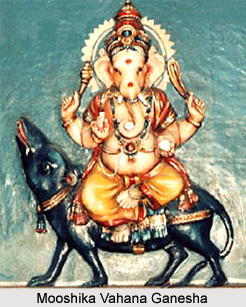 Mooshika Vahana, also known as Musaka Vahana, is one of the thirty-two forms of Lord Ganesha. In this incarnation, the Lord has the divine mouse Krauncha as His mount or vahana. Mooshika Vahana is the one who always holds a modaka or sweet ball in one of his hands and has ears like a hand-held fan. The Lord is short in stature and is the son of Lord Shiva and Parvati. It is believed that the vahana of Ganesha is associated with Karni Mata, a female sage. Hence thousands of mice are found moving freely in the Karnimata Temple at Deshnok, Bikaner.
Mooshika Vahana, also known as Musaka Vahana, is one of the thirty-two forms of Lord Ganesha. In this incarnation, the Lord has the divine mouse Krauncha as His mount or vahana. Mooshika Vahana is the one who always holds a modaka or sweet ball in one of his hands and has ears like a hand-held fan. The Lord is short in stature and is the son of Lord Shiva and Parvati. It is believed that the vahana of Ganesha is associated with Karni Mata, a female sage. Hence thousands of mice are found moving freely in the Karnimata Temple at Deshnok, Bikaner.
The Mooshika Vahana form of Lord Ganesha is worshipped with a particular devotional hymn known as Mooshika Vahana Stotram. It is mentioned as follows-
`Mooshika Vahana Modhaka Hastha,
Chamara Karna Vilambitha Suthra,
Vamana Roopa Maheswara Puthra,
Vighna Vinayaka Pada Namasthe
Deva Deva Sutham Devam,
Jagat Vighna Nayakam,
Hasthiroopam Maha Kayam,
Surya Koti Sama Prabham.
Vamanam Jatilam Kantham,
Hruswa Greevam Mahodharam,
Dhoomra Sindhoora Gandam,
Vikatam Prakatoth Katam,
Eka Dantham Pralamboshtam,
Naga Yagnopa Veethinam,
Tryaksham Gaja Mukham Krishnam,
Sukrutham Raktha Vasasam.
Dandha Panim Cha Varadam,
Brahmanyam Brahma Charinam,
Punyam Ganapathim Divyam,
Vigna Rajam Namayaham.
Devam Ganapathim Nadham,
Viswasyagre Thu Gaminam,
Devaanaam Adhikam Sreshtam,
Nayakam Suvinayakam.
Namami Bhagwantham Tham,
Adbhutham Gana Nayakam,
Vakra Thunda Prachandaya,
Ugrathundaya They Nama.
Chandaya Guru Chandaya,
Chanda Chandaya They Nama,
Mathonmatha Pramathaya,
Nithya Mathaya They Nama.
Umasutham Namasyami,
Ganga Puthraya They Nama,
Omkaraya Vashat Kara,
Swahakaraya They Nama.
Manthra Moorthe Maha Yogin,
Jatha Vedo Namo Nama,
Parswa Pasaka Hastaya,
Gaja Hasthaya They Nama.
Meghaya Megha Varnaya,
Megheswaraya Namo Nama,
Ghoraya Ghora Roopaya,
Ghora Ghoraya They Nama.
Purana Poorva Poojyaya,
Purushaya Namo Nama,
Madothkata Mamosthesthu,
Namasthe Chanda Vikrama
Vinayaka Namosthsthu,
Namasthe Bhaktha Vathsala,
Bhaktha Priyaya Santhaya,
Maha Thejasvine Nama.
Yagnaya Yagna Hothre,
Yagnesaya Namo Nama,
Namasthe Basma Shuklanga.
Shukla Malya Dharaya Cha.
Mada Klinna Kapolaya,
Ganadhipathaye Nama,
Aakhu Vahana Devesa,
Yeka Danthaya They Nama,
Soorpa Karnaya Shraaaya,
Deerga Danthaya They Nama,
Vignam Harathu Devesa,
Shiva Puthro Vinayaka.
Yethan Mooshika Vahasya Stotram,
Sandhya Dwayam Padeth,
Vipro Bhavathi Vedhadya,
Kshathriyo Vijayi Bhaveth,
Vaisyasthu Dhanavapnothi,
Shudhra Papai Pramuchyathe,
Garbhini Janayeth Puthram,
Kanya Bharthara Mapnuyath.
Pravasee Labhathe Sthanam,
Badho Bhandath Pramuchyathe,
Ishta Sidhimavapnothi,
Punathyasaptham Kulam.
Sarva Mangala Mangalyam,
Sarva Papa Pranasanam,
Sarva Kama Pradham Punyam,
Padatham Srunvatham Api.`




















